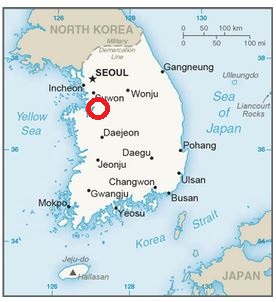#11,896
Potentially, a very big story. For the first time since it emerged in the spring of 2014, the Highly Pathogenic H5N6 virus has been detected outside of it's current range of China (and to a lesser extent) Laos, Hong Kong and Vietnam.
Unlike H5N8, which emerged in South Korea in January of 2014 and subsequently spread - via migratory birds - around the world, the H5N6 virus is known to infect both birds and humans, and can produce severe and even fatal illness.
We've been watching for two years to see if the H5N6 virus would follow the footsteps of H5N1 and H5N8, and begin to spread beyond Mainland China via migratory birds (see H5N6: The Other HPAI H5 Threat).
Today, we have some early signs suggesting it has. South Korea is understandably placing their poultry industry on high alert for additional signs that the virus has arrived.
Highly pathogenic avian influenza is detected in wild birds feces
2016-11-11 10:50:00
Agriculture, Forestry, Animal Husbandry and Food has announced that H5N6-type highly pathogenic avian influenza (HPAI) virus was detected in wild birds feces collected from October 28, Cheonan pungsemyeon M management material bars cloth.
* Detected Inspector: research in wild bird fecal samples from Konkuk harvesting (10.28), jongran vaccination (11.1), our check (11.4) and H5 AI antigen detection (11.9), H5 AI antigen detection requires powerful liquid samples sent to the quarantine division (11.10), H5N6 confirmed and highly pathogenic AI diagnosis (11.11) in poultry farms, raising awareness of such producer organizations, and to provide information to issue a 'migratory caution' stage of "migratory information notification system", and birds of flu engineering defenses conduct point of detection points within a radius of 10km area in accordance with the 'wild bird surveillance specified regions', and movement restrictions for all poultry farmers in the area, surveillance and inspection (11.14 days to), daily disinfection and dedicated public servants designated, conducted a migratory doraeji one days disinfection measures, including biosecurity measures.
* wild bird surveillance area specified when sampling after 14 days from the date of the last if it is determined that there is no longer carried out a complete overhaul in my poultry farm local movement restrictions off agri-food section in the past, poultry breeding farms, when HPAI viruses are detected in wild birds when HPAI occurs * Given a point, not a bird in the wild-type H5N6 HPAI is detected for the first time this year, the importance of biosecurity as a high risk farmhouse farmhouse influx emphasized necessary than ever.
(Continue . . . )
